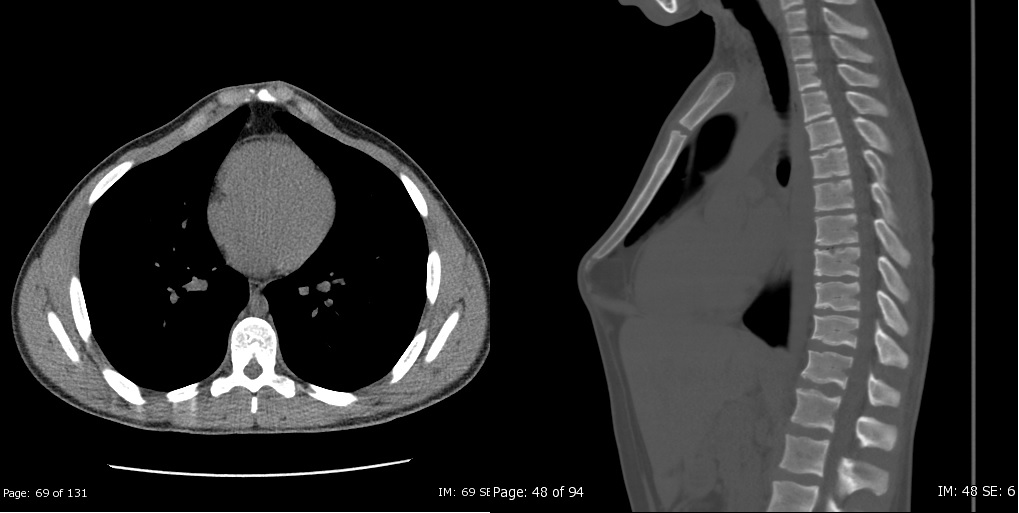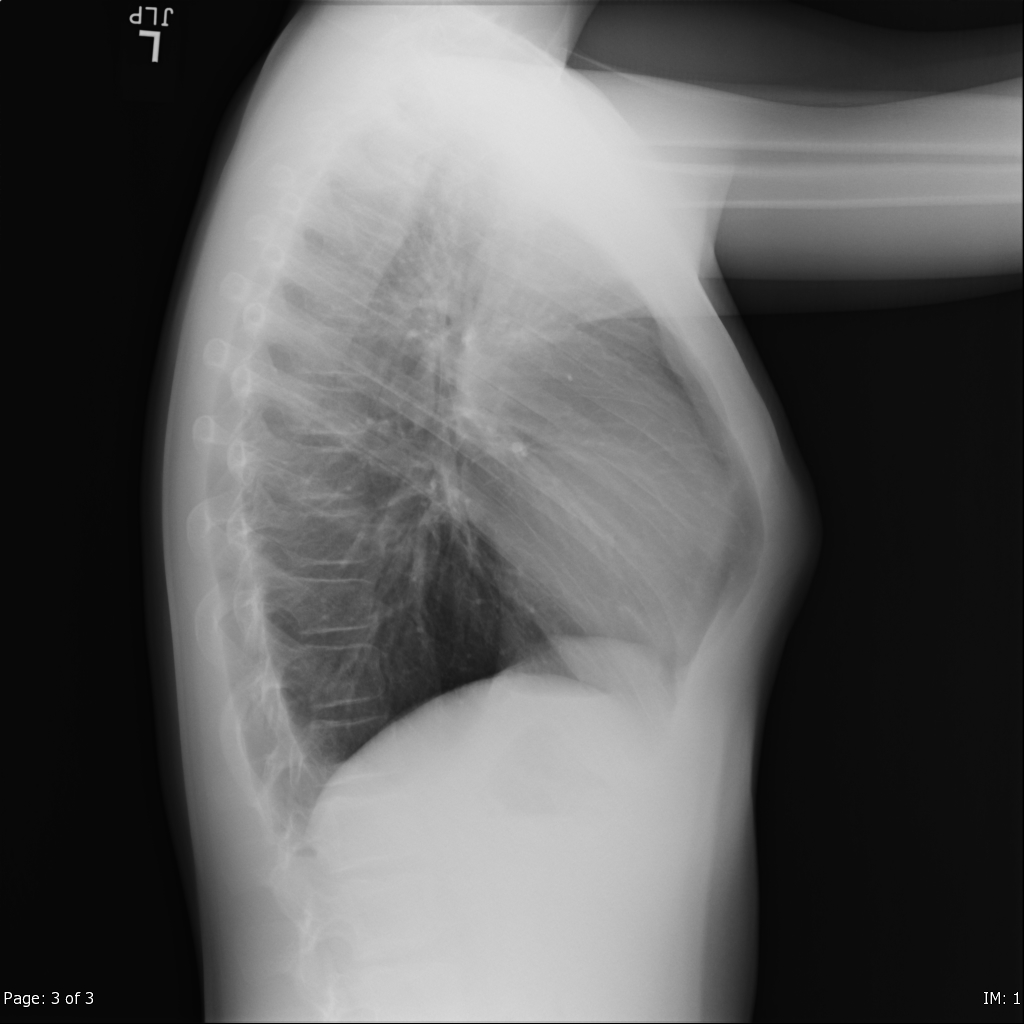[1]
Park CH, Kim TH, Haam SJ, Lee S. Does overgrowth of costal cartilage cause pectus carinatum? A three-dimensional computed tomography evaluation of rib length and costal cartilage length in patients with asymmetric pectus carinatum. Interactive cardiovascular and thoracic surgery. 2013 Nov:17(5):757-63. doi: 10.1093/icvts/ivt321. Epub 2013 Jul 17
[PubMed PMID: 23868604]
[2]
Goretsky MJ, Kelly RE Jr, Croitoru D, Nuss D. Chest wall anomalies: pectus excavatum and pectus carinatum. Adolescent medicine clinics. 2004 Oct:15(3):455-71
[PubMed PMID: 15625987]
[3]
Robicsek F, Watts LT. Pectus carinatum. Thoracic surgery clinics. 2010 Nov:20(4):563-74. doi: 10.1016/j.thorsurg.2010.07.007. Epub
[PubMed PMID: 20974441]
[4]
Coelho Mde S, Guimarães Pde S. Pectus carinatum. Jornal brasileiro de pneumologia : publicacao oficial da Sociedade Brasileira de Pneumologia e Tisilogia. 2007 Jul-Aug:33(4):463-74
[PubMed PMID: 17982540]
[5]
Fonkalsrud EW. Surgical correction of pectus carinatum: lessons learned from 260 patients. Journal of pediatric surgery. 2008 Jul:43(7):1235-43. doi: 10.1016/j.jpedsurg.2008.02.007. Epub
[PubMed PMID: 18639675]
[6]
Haje SA, Harcke HT, Bowen JR. Growth disturbance of the sternum and pectus deformities: imaging studies and clinical correlation. Pediatric radiology. 1999 May:29(5):334-41
[PubMed PMID: 10382210]
[7]
Katrancioglu O, Akkas Y, Karadayi S, Sahin E, Kaptanoğlu M. Is the Abramson technique effective in pectus carinatum repair? Asian journal of surgery. 2018 Jan:41(1):73-76. doi: 10.1016/j.asjsur.2016.09.008. Epub 2016 Nov 4
[PubMed PMID: 27825548]
[8]
Poston PM, McHugh MA, Rossi NO, Patel SS, Rajput M, Turek JW. The case for using the correction index obtained from chest radiography for evaluation of pectus excavatum. Journal of pediatric surgery. 2015 Nov:50(11):1940-4. doi: 10.1016/j.jpedsurg.2015.06.017. Epub 2015 Jun 30
[PubMed PMID: 26235532]
Level 3 (low-level) evidence
[9]
Khanna G, Jaju A, Don S, Keys T, Hildebolt CF. Comparison of Haller index values calculated with chest radiographs versus CT for pectus excavatum evaluation. Pediatric radiology. 2010 Nov:40(11):1763-7. doi: 10.1007/s00247-010-1681-z. Epub 2010 May 15
[PubMed PMID: 20473605]
[10]
Cohee AS, Lin JR, Frantz FW, Kelly RE Jr. Staged management of pectus carinatum. Journal of pediatric surgery. 2013 Feb:48(2):315-20. doi: 10.1016/j.jpedsurg.2012.11.008. Epub
[PubMed PMID: 23414858]
[11]
Jung J, Chung SH, Cho JK, Park SJ, Choi H, Lee S. Brace compression for treatment of pectus carinatum. The Korean journal of thoracic and cardiovascular surgery. 2012 Dec:45(6):396-400. doi: 10.5090/kjtcs.2012.45.6.396. Epub 2012 Dec 7
[PubMed PMID: 23275922]
[12]
RAVITCH MM. Unusual sternal deformity with cardiac symptoms operative correction. The Journal of thoracic surgery. 1952 Feb:23(2):138-44
[PubMed PMID: 14909306]
[13]
Kálmán A. Initial results with minimally invasive repair of pectus carinatum. The Journal of thoracic and cardiovascular surgery. 2009 Aug:138(2):434-8. doi: 10.1016/j.jtcvs.2008.12.032. Epub 2009 Mar 9
[PubMed PMID: 19619792]
[14]
Abramson H. [A minimally invasive technique to repair pectus carinatum. Preliminary report]. Archivos de bronconeumologia. 2005 Jun:41(6):349-51
[PubMed PMID: 15989893]
[15]
Behr CA, Denning NL, Kallis MP, Maloney C, Soffer SZ, Romano-Adesman A, Hong AR. The incidence of Marfan syndrome and cardiac anomalies in patients presenting with pectus deformities. Journal of pediatric surgery. 2019 Sep:54(9):1926-1928. doi: 10.1016/j.jpedsurg.2018.11.017. Epub 2018 Dec 27
[PubMed PMID: 30686517]
[16]
Tomatsu S, Mackenzie WG, Theroux MC, Mason RW, Thacker MM, Shaffer TH, Montaño AM, Rowan D, Sly W, Alméciga-Díaz CJ, Barrera LA, Chinen Y, Yasuda E, Ruhnke K, Suzuki Y, Orii T. Current and emerging treatments and surgical interventions for Morquio A syndrome: a review. Research and reports in endocrine disorders. 2012 Dec:2012(2):65-77
[PubMed PMID: 24839594]
[17]
American Academy of Pediatrics Council on Sports Medicine and Fitness, McCambridge TM, Stricker PR. Strength training by children and adolescents. Pediatrics. 2008 Apr:121(4):835-40. doi: 10.1542/peds.2007-3790. Epub
[PubMed PMID: 18381549]


